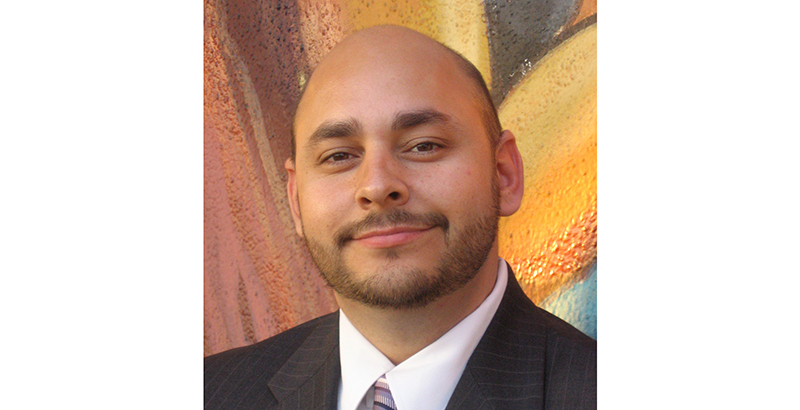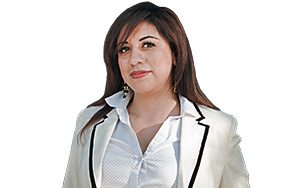Unleashing the Youth Vote: Meet Power California’s Luis Sánchez, Who Hopes to Bring 200,000 New Young Voters to the Polls

This article was produced in partnership with LA School Report.
Luis Sánchez has spent 25 years mobilizing young people in Los Angeles and across California to fight for educational justice, from gaining equal access to a more rigorous curriculum to reducing suspension rates. But he has learned that to release their real power, they need to vote.
“If their generation doesn’t vote, if we lose them as voters for the next 15 years, we’re going to go in the wrong direction as a state and as a nation,” he said. “We want young people to fully embrace their power.”
Sánchez is working hard to make sure young Latinos vote now so that their impact will be felt in the midterm elections.
The organization he founded, Power California, has been responsible in large part for the record number of 200,000 16- and 17-year-olds who have pre-registered to vote in the past two years. Power California, a civic engagement coalition of 25 organizations that mobilizes young voters of color, has pre-registered nearly a quarter of that total — 50,000 — including 25,000 in Los Angeles. Two-thirds of those high-school-age youth will be able to vote this November.
The coalition’s goal this fall is to reach more than 100,000 additional young voters across the state, including 52,000 young adults in L.A. County, where Latinos make up 49 percent of the population.
Activating young voters for these midterm elections is urgent, Sánchez says, because studies show that if young people vote in two consecutive elections, they are more likely to become voters for life. “But if a young person does not register to vote and vote in that first election, they will actually disengage for over a decade.”
Direct contact with young people is a key strategy for Power California, which has found that youth need to be reached through the devices they use most: their phones.
“We were calling them on their cell phones, doing social media ads directed at them as voters, and we were texting them. Our model showed that we were actually able to increase, with first-time voters in the state, voting by 20 percent in the 2016 election,” he said.
If the Latino turnout in the midterm elections is disappointing, lack of direct contact could be a reason. The New York Times reported this week that 55 percent of Latinos nationwide say they have not yet been contacted by a political campaign this year, whether by email, by mail, by phone, or in person.
Despite being the largest ethnic group in California and making up nearly half the population of Los Angeles, Latinos have not yet proven to be the political force their numbers would suggest.
“Ninety-five percent of Latino children under 18 are citizens in California. We have to convert that into political power,” Sánchez said. “We need to focus on the next generation so that they actually get involved and begin to change the trend of [voter] turnout.”
Part of Sánchez’s strategy is reaching the children of immigrants — like he was, growing up in East Los Angeles.
Sánchez, 43, was born in L.A., but his parents are immigrants from Mexico. He was the first in his family to go to college, and also the first voter. He said that most young people who have registered for the upcoming election are first-generation voters.
Nearly 60 percent of all youth under 25 years old in California have at least one immigrant parent in their household, he said, which is why immigration ranked as their top concern in a survey Power California commissioned over the summer.
“The future of California is both youth of color, and they are largely children of immigrants,” he said. “There’s not a tradition of voting for immigrant families. For many children of immigrants, these midterm elections will be the first time to vote. We have to educate them on things like you don’t need an ID to be able to vote and to remind them exactly where and how.”
Less than 21 DAYS until the one of the most critical elections of our time. Young ppl across CA are putting in work to make sure our voices&votes count. Register to vote TODAY @ https://t.co/WM6bGmA9au. Join the hundreds of thousands of young ppl #ReadyToVote on Nov. 6 pic.twitter.com/JfEarkVr3d
— Power California (@PowerCANow) October 16, 2018
Sánchez has spent a quarter-century working with the immigrant community in East Los Angeles, first through InnerCity Struggle, the first Latino-youth empowerment organization he founded, and then by running the 2006 school board campaign for Mónica García, who is now board president.
After her win, he decided to leave InnerCity Struggle and join García’s office as her chief of staff, working on equity issues including decreasing suspension rates and opening access for all students to California’s A-G curriculum, high school courses required for eligibility for the state’s four-year public universities.
But it was during his own run for office in 2011 that he learned how important it is to reach young voters. In fact, he co-founded Power California, along with Aparna Shah, in 2016 to put into practice the insights he gained when he narrowly lost to Bennett Kayser for the District 5 seat on the L.A. Unified School District’s board.
He learned that when young voters are engaged, historically low voter turnout can dramatically spike. That’s what happened in East L.A., when partway through his campaign, he began to target young voters.
“We realized young people’s vote [in the primary] was the lowest ever in a school board election in Los Angeles. Historically, turnout in East L.A. for every school board election going back 10 years had always been less than 1 percent.” But when he started to engage East L.A., that changed.
“What I learned from what we did in East L.A. is that we can get young people involved in elections, especially when you talk to them about the issues that matter to them,” he said.
To find out what mattered to the state’s youth, over the summer Power California commissioned a survey of 2,000 young Californians of color between the ages of 16 and 24 about their civic engagement. The results showed that 72 percent of 18-to-24-year-olds say they will “definitely” vote in November, and 82 percent said voting makes a difference.
Their top issues were immigration, housing, the environment, and education. Half the respondents considered themselves part of the Black Lives Matter movement, LGBTQ Equality, and Undocumented and Unafraid social movements.
“They are living in a time of racism that we haven’t seen since when I was growing up … and now we have Trump attacking our communities,” Sánchez said. “I hate that it is happening like this, but at the same time I think this is why we are reaching record numbers of people registering to vote in California.”
Today. Is. The. Day. The California voter registration deadline is here! Register yourself and your friends to vote at https://t.co/t4XpQi2U9p and make sure you’re ready for the November General Election #VoteCalifornia pic.twitter.com/Ij4zLqSsqd
— CA SOS Vote (@CASOSvote) October 22, 2018
Part of Power California’s success in pre-registering so many teens has been its partnership with L.A. Unified, the state’s largest school district. Power California supported an L.A. Unified school board resolution, unanimously approved in August, that committed the district to promote civic engagement among its high school students. The resolution declared Sept. 25 as High School Voter Registration Day, which the district marked with an event at Polytechnic High School.
Sánchez said Polytechnic alone has pre-registered 1,300 students in the past year and a half and that students there feel motivated in part because they have been educated about why their vote is so important. “They know they will be voting for a new governor, for a new state superintendent, new sheriffs, and they now know how critical that is,” he said.
Ahead of the midterm elections, Power California aims to call every young person in Los Angeles and Orange counties, the Central Valley and Riverside, and across the state to encourage them and help them vote.
Young people need to be mobilized and know what it means to vote, to be a voter, Sánchez said. “They need to know where to vote, what time, what are the rules and regulations.”
He feels optimistic about the numbers. The 200,000 16- and 17-year-olds who have pre-registered to vote in the past two years could very well bring home a bigger impact than in the last midterm election, in 2014, when only 285,000 voters 18 to 24 turned out.
“There’s an amazing energy around all these movements that are happening, but we can’t take it for granted,” he said. “It needs to translate into political power.”
Get stories like these delivered straight to your inbox. Sign up for The 74 Newsletter

;)
